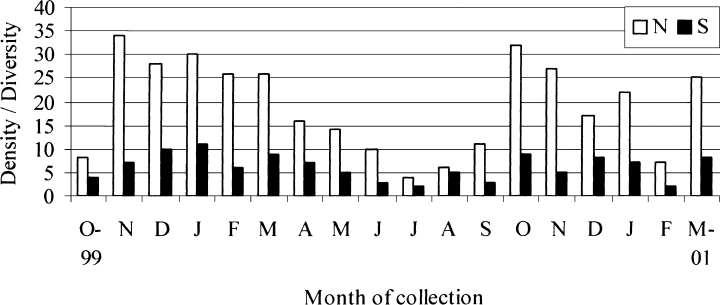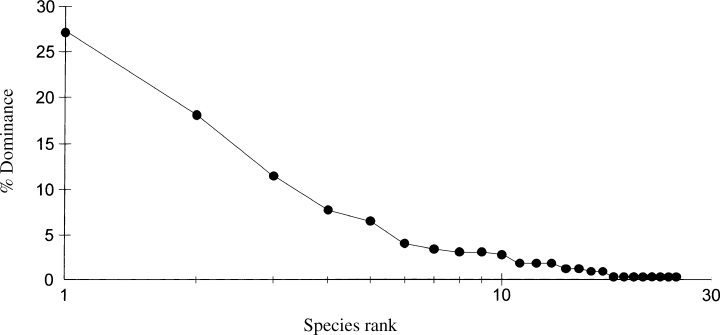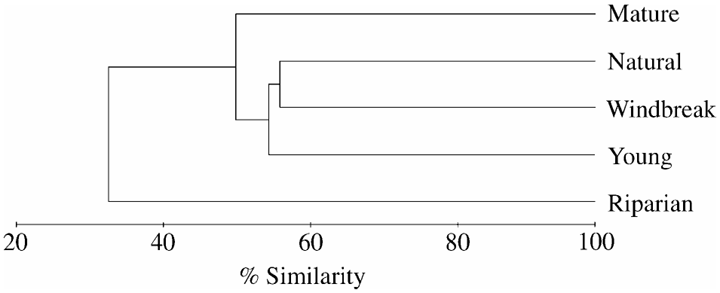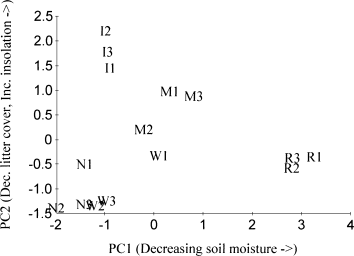Changes in carabid beetle diversity within a fragmented agricultural landscape
Abstract
enThe distribution of carabid and cicindelid (Coleoptera: Carabidae) beetles in five distinct habitats (riparian, mature orchard, pine windbreak, young orchard, natural veld), within Tambuti Citrus Estate (Swaziland) was examined by pitfall trapping over 18 months. Habitats with high vegetation and litter cover had the highest species diversity and larger specimens, e.g. riparian border and pine windbreak, while the lowest diversity was observed in intensively managed mature citrus orchards. While species such as Tefflus delagorguei Guérin occurred in all the habitats sampled, certain species illustrated habitat specificity; e.g. Dromica ambitiosa Péringuey was observed only in the pine windbreaks while Haplotrachelus sp. Chaudoir occurred mainly in the vegetated riparian and natural veld habitats. Four unidentified carabid beetles were exclusive to the riparian border habitat. This habitat was the only one with a distinct assemblage of species in the agricultural mosaic studied. Multivariate analyses were used to assess the role of soil and environmental variables in relation to the ground beetle diversity within the agricultural mosaic studied.
Résumé
frLa distribution des carabes et des cicindèles (Coléoptères: Carabidae) dans cinq habitats distincts (riverain, verger mature, coupe-vent de pins, jeune verger, prairie naturelle) dans le Tambuti Citrus Estate (Swaziland) a été examinée pendant 18 mois au moyen de pièges. Les habitats qui avaient la végétation la plus haute et une litière présentaient la plus forte diversité en espèces et les plus grands spécimens, c'est-à-dire l'habitat riverain et les coupe-vent de pins, tandis qu'on observait la plus faible diversité dans les vergers de citronniers intensément gérés. Alors que des espèces comme Tefflus delagorguei Guérin se retrouvaient dans tous les habitats étudiés, certaines espèces illustraient une certaine spécificité, par exemple Dromica ambitiosa Péringuey, qui n'a été observée que dans les coupe-vent de pins tandis que Haplotrachelus sp. Chaudoir se trouvait surtout dans les habitats riverains et les prairies naturelles. Cinq coléoptères carabidés non identifiés se trouvaient exclusivement dans l'habitat riverain. Cet habitat était le seul à avoir un assemblage d'espèces distinct dans la mosaïque agricole étudiée. Des analyses multivariées ont été utilisées pour évaluer le rôle du sol et des variables environnementales par rapport à la diversité des coléoptères dans le sol de la mosaïque agricole étudiée.
Introduction
Agriculture is the basic mechanism by which humans manipulate and disturb the natural landscape, as observed in Swaziland citrus estates where the indigenous savanna landscape is transformed into a patchwork of habitat mosaics. This is one direct cause of the loss of natural habitats (Gilpin, Gall & Woodruff, 1992; Fry, 1995). The variety of patches means that the land mosaic is highly heterogeneous, with varying types and suitability of habitats for the organisms occurring within the patches (Forman, 1997). Landscape fragmentation for agricultural use inevitably results in habitat destruction and loss of organisms occurring within that biotope.
Due to their small size and dispersal ability, insects, especially apterous species and juvenile stages, are one of the main groups of organisms which can lose their habitat as a result of agricultural activity. Insects are sensitive to ecosystem change or disruptions and their distribution is affected by changes in the availability of a suitable habitat. If such habitats are reduced by anthropogenic activity, there is a reduction in the total amount of habitat available to the insects, and this poses a threat to their survival. Habitat destruction is one of the major factors leading to insect species scarcity (New, 1984; Gilpin et al., 1992; Samways, 1994).
The spatial arrangement of the various habitats within the agricultural mosaic is important for insect mobility and ensures the long-term survival of populations, especially predatory species (Burel & Baudry, 1995; Samways, Tate & Murdoch, 1987). The maintenance or creation of a mosaic of natural and semi-natural habitats thus offers a heterogeneous spectrum of habitats and provides for a greater insect diversity. The preservation of these insects, especially predaceous species, increases the potential for natural enemy control. In addition, predator preservation results in an increased faunal diversity of the agricultural landscape. This study was aimed at ascertaining carabid beetle diversity within various habitat mosaics occurring within and around an agricultural landscape.
Materials and methods
Study area
The experiment was carried out at Tambuti citrus estate (26.43°S, 31.43°E) in the low veld of Swaziland. Tambuti estate has 931.6 ha under citrus, the rest of the estate being natural savanna bushveld and recently established sugar cane fields. The Great Usuthu River borders the estate on the eastern and southern sides. Tambuti thus has a variety of natural, semi-natural and anthropogenic mosaics. During sampling, the habitats chosen were the indigenous savanna, riparian border, pine windbreak, a young citrus orchard and an old citrus orchard. In total therefore, five types of landscape elements were sampled (Table 1).
| Site | Habitat type | % Soil moisture | Litter cover | Insolation | pH | Management type | Dominant tree/shrub | Mean body length (mm) ± SD |
|---|---|---|---|---|---|---|---|---|
| 1 | Riparian | 0.394 ± 0.115 | 10 | 0 | 5.624 ± 0.569 | 1: Unmanaged (natural) | Lantana | 15.943 ± 9.466 |
| 2 | Mature orchard (>3 years) | 2.060 ± 0.127 | 5 | 2 | 5.523 ± 0.317 | 2: Agricultural management: irrigation, pruning, mowing, fertilisers, pesticides | Citrus | 24.560 ± 16.099 |
| 3 | Windbreak | 2.102 ± 0.437 | 10 | 2 | 6.960 ± 0.362 | 3: Cultural management: irrigation, pruning only | Pine | 27.829 ± 16.964 |
| 4 | Young orchard (<3 years) | 1.981 ± 0.226 | 1 | 5 | 6.477 ± 0.352 | 2: Agricultural management: irrigation, pruning, mowing, fertilisers, pesticides | Citrus | 24.314 ± 20.182 |
| 5 | Indigenous savannah | 3.045 ± 0.576 | 10 | 3 | 6.920 ± 0.111 | 1: Unmanaged (natural) | Acacia, Tamboti | 35.969 ± 13.783 |
Sampling method
Stratified random sampling was used in assessing carabid populations within the various landscape elements. Pitfall trapping was chosen, since it is the one consistently reliable method that provides a measure of species activity for epigaeic macroinvertebrates (Samways, 1990; French & Elliot, 1999).
Each point habitat was sampled using a set of four pitfall traps representing the corners of a 1 m2 quadrant. Each set of four traps represented a point sample replicated three times. Each of the five sites thus had three sampling point habitats, giving a total of 12-point habitats per sampling site, with 60 pitfall traps in total.
The pitfall traps consisted of an inner round plastic cup and an outer PVC pipe placed flush with the soil surface. The inner cup was half-filled with anti-freeze (ethylene glycol), which acted as a collecting fluid and preservative. The outer PVC pipe was sunk into the ground and remained there for the duration of the study in order to minimize disturbance of the sampling environment. In order to minimize the deposition of debris and rainwater in the traps, roofing constructed from PVC guttering was used to cover them. The ‘roofs’ were cut so as to create openings from four sides.
The sample traps were serviced every fortnight, with the simultaneous collection of specimens. The study commenced in October 1999 and counts were taken for 18 consecutive months.
The following environmental variables were measured at each site: soil pH, soil moisture (%), per cent insolation and per cent litter cover, as well as the mean body size of specimen. Per cent insolation and litter cover were measured as a percentage of a 1 m2 quadrant vegetation exposed to sunlight for percentage insolation or under leaf litter for percentage litter cover. The percentage means were then scored on a 10-point scale, e.g. 0–5% was given a score of 0, while 96–100% was given a score of 10. Habitat and management types were recorded as nominal variables (Table 1).
Statistical analysis
Statistical analyses was carried out using multivariate statistical tests in order to test for differences between and within the sites sampled, as well as for any relationships with the environmental variables measured. The statistical packages Primer and SPSS were used where appropriate.
Identification
Specimens were sent to the Northern Flagship Institute (Transvaal Museum) for identification. They were only able to identify seven of the 25 ground beetles to species or genus level; the rest were identified only to the family level.
Results
Overall, a total of 320 carabid beetles representing 25 species of carabid species were collected over the period of sampling (beetles previously classified as the Family Cicindellidae were included (Evans & Bellamy, 1996)). A species abundance curve indicated that one species, Tefflus delagorguei Guérin, was dominant with 27.1% of the total number of specimens collected (Fig. 1). January 2000 had the highest species diversity (S = 11), while July 2000 and February 2001 had the lowest (S = 2) (Fig. 2).

Rank abundance curve for all habitats samples at Tambuti Citrus Estate from October 1999 to March 2001. One species, T. delagorgui dominated, contributing to 27.1% of the total number of species collected

Number of ground beetles and species diversity per month over the sampling period
Considering habitat analysis, the highest number of beetles was collected from the riparian habitat with a total of 97 specimens, representing 14 species. Despite having the lowest number of beetles collected (N = 20), the mature orchard had a species diversity comparable to the natural savanna, which had a higher number of beetles collected (N = 77) (Table 2). Differences in the number of individuals collected between the habitats were highly significant (P = 0.004). Differences in species diversity were however, not statistically significant (P = 0.124). This was also confirmed by the Shannon diversity indices for all the sites, which were not significantly different from each other (P = 0.563) (Table 1). In addition, 12% of the species –Tefflus delagorguei, Haplotrachelus sp. Chaudoir and Carabid no. 4 – dominated, making up 56.9% of the total collected while 64% of the species contributed less than 3% of the total collection. Two of the three species –T. delagorguei and Carabid no. 4 – were classified as common within this agricultural landscape since they were collected more than once from all the habitats sampled. Eight other species were considered to be rare since they had single occurrences over the sampling period. The distribution of the species was not significantly different between the habitats (P = 0.905). Species with single site occurrences (occurring more than once in only one site) were significantly different between the sites (P > 0.001). The riparian border had three unidentified carabid species exclusive to it and the young orchard had one species exclusive to it, while the remaining three habitats each had no species exclusive to them (Table 2).
| Site | Total no. collected (N) | Species density (S) | Shannon's H′ | Most common species (% of total per site) | Species unique to site |
|---|---|---|---|---|---|
| Riparian border | 97 | 14 | 2.072 | no. 4 (17.5), no. 15 (21.6), no. 17 (10.3), no. 22 (25.8) | 3 unidentified spp. |
| Mature orchard | 20 | 9 | 1.817 | T. delagorguei (40), no. 4 (20) | – |
| Windbreak | 37 | 11 | 1.724 | T. delagorguei (48.7), D. ambitiosa (18.9) | – |
| Young orchard | 89 | 10 | 1.52 | T. delagorguei (39.3), no. 4 (30.3), no. 3(10.1) | 1 unidentified sp. |
| Indigenous savanna | 77 | 9 | 1.652 | T. delagorguei (28.6), Haplotrachelus sp. (37.7) Cypholoba sp. (10.4), no. 4 (10.4) | – |
At the 60% level of similarity, the dendogram from a cluster analysis of the species composition in the five habitats indicated that the habitats could be divided into four groups (Fig. 3). The riparian border was the most dissimilar from all the other habitats. This could be explained by the observation that this habitat had the highest species diversity exclusive to it while the more common species, e.g. Tefflus delagorguei, occurred in very low numbers within this habitat. The species composition of the riparian border was significantly different from the remaining four habitats (P = 0.005). The second branch consisted of the mature orchard. While this habitat had four species in common with the remaining three habitats –T. delagorguei, Haplotrachelus sp. and Carabidae nos 4 and 13 – it had a lower species diversity and number of beetles collected. The highest similarity was observed between the natural savanna and the windbreak, with seven species in common –T. delagorguei, Haplotrachelus sp., Cypholoba Chaudoir, Dromica ambitiosa Péringuey, Graphipterus Latrielle, Carabid nos 4 and 13. Multidimensional scaling (MDS) resulted in similar groupings as those taken from the dendogram.

Dendogram of hierarchical cluster analysis of all habitats sampling using Bray–Curtis similarities
To further investigate the groups observed from cluster analysis, the habitats were analysed against all the measured environmental variables using a Principal Component Analysis (PCA). PCA also separated the habitats into four groups which were similar to the cluster analysis (Fig. 4). The first component was a decreasing gradient of soil moisture, explaining 57.6% of the observed variability. The second axis was a gradient of decreasing litter cover and increasing insolation, explaining 28.4% of the variability. Both components explained 86.1% of the variability observed in the environmental variables measured.

Principal Component Analysis of the measured environmental variables for the five habitats sampled. Total variance explained by the first two components is 86.1%
There were some differences in the number of beetles collected between the three management types (disturbances). Unmanaged habitats, i.e. the riparian border and savanna, had the highest number of beetles collected and species diversity (N = 174, S = 18). Although the windbreak (cultural management) had the lowest number of beetles collected (N = 37), it had a species diversity of 11, which was marginally lower than that observed in the managed habitats (immature and mature orchards, S = 14, N = 109). Differences in species diversity and number of beetles collected were, however, not significant relative to the management type (disturbance) during the study period (P > 0.05).
The average body length of beetles collected from each site was significantly different between the five habitats (P = 0.000), with the largest beetles collected from the natural savanna forest (Table 1), while the shortest average length was from specimens obtained from the riparian habitat. The average body size was not related to the habitat or management type.
Discussion
These results indicated that three carabid species –Tefflus delagorguei, Haplotrachelus sp. Chaudoir and Carabidae no. 4 – dominated the agricultural landscape assessed. Although occurring in lower densities in the riparian border and mature orchard, all the three species were present in all five habitats sampled and made up 56.9% of the total collection. T. delagorguei and Carabid no. 4 were considered to be common eurytopic species within the agricultural landscape studied, since they occurred more than once in all five landscape types sampled. Results indicated that these two species are multihabitat species (Forman, 1997) which are are tolerant to the various habitats and were therefore able to exploit the various niches within these habitats. Further investigations on the ecology of the species would provide information on the methods of their survival, e.g. sites for reproduction and prey species. While a large amount of ecological information on this family is available, it is presently restricted to taxa in the northern hemisphere (Gullan & Cranston, 1994). The occurrence of these species throughout the sampling area indicated that there is a movement of these beetles between the habitat patches in the estate. Most entomophagous species such as the carabid beetles are polyphagous and their prey are not restricted to one particular habitat so that predator movement is also expected. Their movement enhances the value of the natural habitats within an agricultural landscape, since such habitats could act a reservoirs or sinks for carabid beetle diversity. The observed movement of carabid beetles between the five habitats may thus indicate the high flow between the natural, semi-natural and managed habitat mosaics (Duelli, 1988). Eight species could be considered to be rare, i.e. they had single occurrences and were not significantly different between the sites. With consideration of the relatively short sampling period, these species may be rare due to a temporary drop in their population levels in this landscape (Samways, 1994).
The main determinants of carabid beetle fauna are known to be vegetation cover, soil moisture, distance from running/standing water and altitude. This could explain our inability to stratify species composition and distribution patterns of the beetles based on the management type in this study. Categorizing the habitats into the three nominal categories was purely subjective. A combination of the riparian border habitat with the natural savanna veld in the same category probably resulted in poor definition, since these habitats had different vegetation cover, soil type and moisture content, as was observed from the results. Our discussion is thus based on the classification of habitat types, since vegetation cover was one of the criteria used to make a distinction between the habitats, resulting in the five habitats assessed.
The natural habitats had higher species diversity of carabid beetles than the managed orchard habitats. These differences were not significant however. A survey of ladybeetles (family Coccinellidae) in the same agricultural mosaic indicated that the managed orchard habitats had higher species diversity and populations. This may be explained by the fact that prey availability is the main determinant of coccinellid distribution (Duelli, 1988; Magagula & Samways, 2001). The indigenous savanna and riparian habitats were, however, found to be important as refuges thus maximizing ladybeetle diversity.
The riparian border habitat was the only habitat with an exclusive assemblage of resident carabid beetles which could be used as ‘indicators’ of this habitat. These species were locally abundant within this habitat, while not occurring in any of the other habitats assessed and were thus considered to be biotope specific, i.e. stenotopic (Samways, 1994). This finding is in contrast with a study by Bedford & Usher (1994) where the less disturbed habitats had fewer ‘indicators’ and the cultivated areas had more ‘indicator’ species. The species assemblage from this habitat may be used to characterize it as an ecologically meaningful unit and emphasizes the ecological function of all habitat patches within this mosaic (Forman & Godron, 1986). This site was dominated by the alien weed, Lantana camara, and the restriction of these species to this habitat illustrates that alien vegetation has an effect at the species level rather than at higher taxonomic levels. The low numbers of the eurytopic species emphasizes that landscape fragmentation increases the abundance of some species while decreasing others within the various habitat patches (Samways, Caldwell & Osborn, 1996).
The natural savanna had significantly higher levels of Haplotrachelus sp. Chaudoir, with 78.4% of them occurring in this habitat, followed by the riparian border habitats (13.5%). Members of this genus belong to the Scaratiinae, a group characterized by leaf litter inhabitants. It is therefore probable that their absence from the disturbed habitats, e.g. the orchards, could be due to the low litter/leaf cover within these habitats. Characterization of the remaining three habitats based on species composition was not possible since there were no clearly defined species assemblages for these. Due to the restriction of certain species to particular habitats, the infrastructure of the Tambuti agricultural landscape has an impact on the maintenance of ground beetle populations and emphasizes that habitat management should be sensitive to the needs of the species inhabiting them. Maintenance of predator species like the carabid beetles maximizes natural control while minimizing chemical control. The contribution of spiders, carabids and staphylinids towards the natural control of agricultural pests is well known. (Kromp, 1989; Samways, 1989; Booij & Noorlander, 1992).
These results indicate that particular land cover types indicate specific carabid beetle fauna within habitats and similarly, soil characteristics, i.e. soil moisture, litter cover and insolation were also found to be good determinants of the distribution patterns of the carabid beetles as observed in multivariate analysis. The importance of soil characteristics is known to be one of the important factors that affect carabid beetle communities (Jaganyi, 1998) but this is contrasted with results from a survey of ladybeetles within the same agricultural mosaic. Prey availability, as opposed to any environmental variable, usually determines ladybeetle distribution (Magagula & Samways, 2001).
Corridor habitats like the windbreak are important links between habitat units in a mosaic, in this case the orchards. The windbreaks minimize undue fragmentation by enabling some passage of organisms between the habitat patches and this was observed in the similarity of species occurrences between the windbreak and the orchards, especially the immature orchard. Such habitats act as refuges for predatory and non-target species and allow re-invasion after chemical treatment in the orchards (New, 1984; Duelli, 1988; Varchola & Dunn, 1999). In general, increased landscape disturbances result in a decrease in abundance of sensitive species and only those with a high adaptability tend to thrive. In this study, the results indicated that species such as T. delagorguei seem to have a high adaptability and thrived in the intensely managed young orchard, while others like Haplotrachelus sp. and Carabid no. 15 were restricted to the natural habitats. Such species may thus be reflective, not only of habitat diversity but also of human impact within the agricultural mosaic studied.
The migration of beetles between the natural, semi-natural and managed habitats emphasizes the importance of all habitat elements within the agricultural landscape (Booij & Noorlander, 1992). This is particularly important for species recovery after disturbances, e.g. chemical treatment, mowing, pruning, etc. While carabids are restricted to particular habitats, they are able to move to different habitats in response to environmental changes (Bedford & Usher, 1994). Habitat fragmentation as observed in Tambuti Citrus Estate enables the preservation of biotic diversity, since the various landscape elements provide a suitable habitat for carabid and ladybeetles within the hostile matrix. This is because the presence of the various habitat types enables a conservation of communities rather than individual species, as observed in this study and that on ladybeetles. Additionally, the preservation of these habitats also enables generalist carabid and coccinellid species such as T. delagorguei, Cheilomenes lunata (Fabricius) and Nephus sp. etc. to survive (Magagula & Samways, 2001). The activity of predaceous insects like carabids, staphyllinids and coccinellids in pest control is well documented (Hodek, 1973; Booij & Noorlander, 1992; Majerus, 1994). Predator conservation, however, cannot be achieved only through a reduction in pesticide use. The spatial pattern of natural and semi-natural habitats also has a major impact on the maintenance of biotic diversity and ecosystem function.




